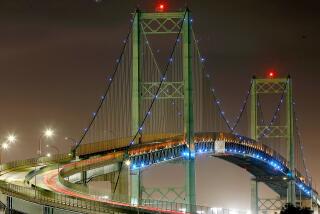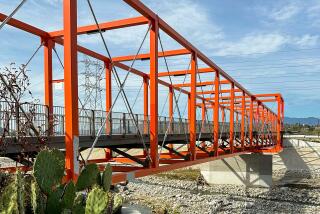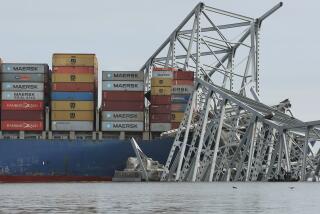Plastic Bridge Will Take Cars Into the 21st Century
- Share via
MORRISTOWN, Vt. — It’s taken two years into the new millennium, but the state of Vermont is about to complete its bridge to the 21st century.
It’s not a political slogan, but an actual bridge, reinforced with plastic and outfitted with fiber-optic sensors that allow traffic and stress on the structure to be monitored from 50 miles away.
Its designers say it will be the first bridge of its kind in the world--unique in that neither of the two layers of the reinforcement bar, or rebar, grid that give strength to its concrete deck is made of steel.
Instead, they’ve been built out of “glass-fiber reinforced polymer,” which engineers say has a distinct advantage over traditional steel: It doesn’t corrode. That’s a key consideration in a state where roads and bridges take a beating every winter from ice, snow and road salt.
The high-tech bridge sits between farmers’ fields and runs 144 feet across the Ryder Brook, a tributary of the Lamoille River, on heavily traveled Route 100 between Morrisville and Stowe.
About 7,000 vehicles a day are expected to cross it after it opens in the fall; they’re doing so now on a temporary bridge on the detour that dips down around the construction site.
Thirty-four-feet wide, it replaces a bridge that was just 21 feet from curb to curb and at least once has seen two large trucks become wedged between its rails and back traffic up for miles.
Ray Hayes, resident engineer and project manager, and Tom Lackey, design engineer with the state Agency of Transportation in Montpelier, spent half an hour one recent morning inside a weather-beaten green construction trailer flipping through the design drawings for the bridge.
Hayes, a Morrisville native, made clear that he’s taking the whole idea of being a bridge construction pioneer easily in stride. “I haven’t gotten very excited about it, tell you the truth,” he said.
The new rebar is easier to work with because it’s lighter, he said: less than half a pound per foot as opposed to a pound and a half for the steel.
“Some of these bars we use are 30 feet long. You see two guys grab 10 of them at once and bring them somewhere--it’s different from what we’re accustomed to,” he added with a smile.
The polymer costs a bit more than traditional steel. It will add about $50,000 to the bridge’s $1.4-million price tag--with the difference covered by a federal grant. But it’s expected to at least double what otherwise would be expected to be a 40-year life span for the bridge’s deck.
Phil Phelps, construction foreman for the general contractor, Blow & Cote Inc. of Morrisville, said his crew considered the plastic rebar a mixed blessing.
“It’s rough,” he said of the material’s texture. “It’s hard on your hands. But in fact putting it in is quite easy because it’s light.”
Aside from the plastic innards, the bridge has other features that make it unusual, at least within Vermont, Lackey said.
Traditional bridges have bearings at either end, where the abutments meet the deck, to allow for expansion and contraction with the weather. The Ryder Brook bridge instead features a system called “integral abutments,” which pivot slightly from the bottom, where they’re better protected from the elements.
Another feature common in other states but not in Vermont is that the bridge will have a bare concrete deck, rather than one covered in asphalt.
The advantage: “When the deck starts to rot, you can see it,” Lackey said.
It was a long and hectic day in May when a crew of 18 gathered at the bridge to pour the concrete deck, Hayes recalled. Some spots still need a bit of touching up.
“Everybody else is satisfied with it, but I’m not,” said Hayes, who freely acknowledged that he’s something of a perfectionist.
Aside from the human eyes checking the concrete deck for signs of wear, there will be the fiber-optic sensors.
Reading the printouts from them will be Brahim Benmokrane, a professor of civil engineering at Quebec’s University of Sherbrooke.
Benmokrane “asked if he could come down and put some sensors in our bridge. We said sure,” Lackey said.
Benmokrane, who was trained in Switzerland, said he and his team of researchers will be monitoring the bridge to see how well the plastic rebar holds up over time. The monitors will also allow the team to track temperatures at the bridge, the stresses that are being put on the structure and even the weight of individual vehicles traveling over it.
Benmokrane said he expects such sensors to become more common in bridges and buildings in the coming years, with the main purpose being “structural health monitoring. If it needs repairs, if there is something going wrong, you can know it.”
More to Read
Sign up for Essential California
The most important California stories and recommendations in your inbox every morning.
You may occasionally receive promotional content from the Los Angeles Times.










